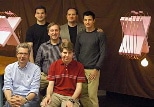At the recent TED Global Conference in Oxford, UK, a US-based technology firm, WiTricity, demonstrated a system that delivers electricity through the air to power laptops, cell phones, and other electrical devices. This new system is based on the work of Professor Marin Soljacic, a physicist at the Massachusetts Institute of Technology. The concept of sending power wirelessly is not new (think Tesla), but it had been considered impractical because electromagnetic energy radiates in all directions. The coils Prof. Soljacic developed rely on the resonance of low-frequency electromagnetic waves, in which energy transfer becomes more efficient. When two objects have the same resonant frequency, they exchange considerable energy with each other without having an effect on surrounding objects. A magnetic coil resonates at a certain frequency, which can be implanted in a wall, floor, ceiling, or beneath a desk. A second magnetic coil, embedded in the phone or laptop, resonates at the same frequency and absorbs energy. Interestingly, Prof. Soljacic embarked on this research not after some profound insight, but after being annoyed and awakened by the beeping of his low-battery cell phone.A further explanation of this technology can be found on the WiTricity website.
System Uses EM Waves to Deliver Wireless Power through the Air






